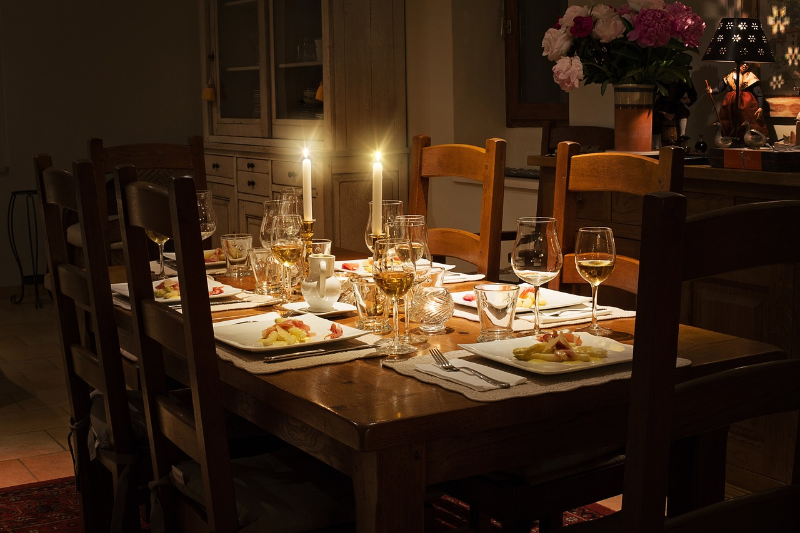의전 및 국제회의 식탁 예절
( Protocol & Table Manners at International Conference
Dinners and Lunches Seating Etiquette )

국가 및 일반 의전
협의적 의미에서
의전은 국가 행사, 외교적 약속,
국가 원수와 고위 공무원의 방문 및 접견 중에
지켜지는 국제적 예의를 말합니다.
더 넓은 의미에서 의전은
사회 구성원으로서 각 개인이 지켜야 할
건전한 상식에 근거한 에티켓을 포함합니다.
1. 국가 의전
국가 의전은 다음 중에 지켜지는 에티켓을 포함합니다.
1) 국가 행사 : 국가 원수와 고위 인사가 참여하는 의례 활동.
2) 외교 행사 : 공식 회의 및 협상 중 주권 국가 간의 에티켓.
3) 외교 사절 : 외교 대표를 파견하고 접견할 때의 적절한 행동.
4) 방문 및 접견 : 국가 원수와 고위 공무원의 방문 및 접견 중의 의정서.
2. 사교의례 ( 일반적 예절)
사교의례에는 사회 구성원으로서 각 개인이 지켜야 할 예절이 포함됩니다.
1) 외교적 예절 : 외교관 간에 지켜야 할 규칙, 상호 존중과 예의범절 유지.
2) 일상생활 예절 : 일상적인 상호작용에서 기대되는 기본적인 매너와 행동.
3) 상식적 예절 : 존중심이 강하고 잘 기능하는 사회에 기여하는 최소한의 행동 기준.
본질적으로 의례와 예절은
행동과 상호작용을 안내하여
공식적인 국가 업무와 일상적인 사회적 상호작용 모두에서
존중과 원활한 의사소통을 보장합니다.
이러한 규칙을 준수하면 다양한 환경에서
조화와 상호 존중을 유지하는 데 도움이 됩니다.

Protocol in State and Society
Protocol, in a narrow sense,
refers to the international courtesy observed during state events,
diplomatic engagements,
and visits and receptions of heads of state and high-ranking officials.
In a broader sense, it encompasses etiquette
based on sound common sense
that each individual must observe as a member of society.
1. State Protocol
State protocol involves the etiquette observed during:
State Events:
Ceremonial activities involving heads of state and dignitaries.
Diplomatic Events:
Etiquette between sovereign states
during official meetings and negotiations.
Diplomatic Envoys:
Proper conduct during the dispatch
and reception of diplomatic representatives.
Visits and Receptions:
Protocols during the visits and
receptions of heads of state and high-ranking officials.
2. Social Etiquette
Social etiquette includes the etiquette each individual
must observe as a member of society:
Diplomatic Etiquette:
Rules observed between diplomats,
maintaining mutual respect and decorum.
Daily Life Etiquette:
Basic manners and conduct expected in everyday interactions.
Common Sense Etiquette:
The minimum standards of behavior
that contribute to a respectful and well-functioning society.
In essence, protocol and etiquette guide behavior and interactions,
ensuring respect and smooth communication,
both in formal state affairs and daily social interactions.
Observing these rules helps maintain harmony
and mutual respect in various settings.

국제회의 만찬 및 점심 식사에서의 테이블 매너
좌석 에티켓
남성 손님은 의자 뒤에 서서
오른쪽에 앉은 여성의 의자를 뒤로 당겨 앉도록 도와줍니다.
모든 여성 손님이 앉은 후에야 앉습니다.
자세와 테이블 위치
손목을 가볍게 테이블에 올려놓되
팔꿈치는 테이블에 닿지 않게 합니다.
팔짱을 끼거나 머리카락을 만지지 마세요.
다리를 가까이 모으고 의자에서 멀리 떨어진 곳에 앉으세요.
다리를 앞으로 뻗거나, 테이블 아래로 휘두르거나,
신발을 벗는 것은 무례한 것으로 간주됩니다.
테이블 행동
칼이나 포크로 사람이나 물건을 가리키지 마세요.
몸을 꿈틀거리거나 시계를 자주 확인하지 마세요.
옆에 있는 사람과 자연스러운 대화를 나누고,
큰 소리로 말하거나 대화를 주도하지 마세요.
개인 소지품
식사할 때는 핸드백을 테이블 위가 아닌 등 뒤에 두세요.
소음과 매너
테이블에서 큰 소리를 내거나 웃는 것을 피하세요.
재채기나 하품을 하면 사과하지만,
코를 푼 것에 대해서는 사과할 필요가 없습니다.
식탁에서 트림하는 것은 금지되어 있습니다.
이쑤시개와 화장품 사용
특히 여성의 경우 식탁에서 이쑤시개를 사용하지 마십시오.
화장이나 화장은 식탁이 아닌 욕실에서 하십시오.
냅킨 에티켓
냅킨을 반으로 접어 접힌 면이 보이도록 무릎 위에 올려놓으십시오.
잠시 자리를 비울 경우 냅킨을 의자에 올려놓고,
끝났다는 것을 나타내기 위해 테이블에 올려놓으십시오.
냅킨은 설거지나 땀을 닦는 것이 아니라 입술을 가볍게 닦는 데 사용하십시오.
식기 사용
포크와 나이프는 접시의 가장 바깥쪽에서 가장 안쪽까지 사용하십시오.
포크는 왼손에 잡되 음식을 자른 후 손을 바꿔도 됩니다.
포크와 나이프를 접시에 8자 모양으로 놓으면 아직 먹고 있다는 것을 나타냅니다.
오른쪽에 깔끔하게 놓으면 다 먹은 것입니다.
빵과 수프 에티켓
빵은 입에 직접 대지 말고 한 입 크기로 손으로 먹으세요.
수프가 나온 후에 빵을 먹고 디저트 전에 다 먹으세요.
수프를 먹을 때 소리를 내지 마세요. 접시를 기울이지 마세요.
음식 다루기
빵을 제외하고는 손으로 음식을 먹지 마세요.
과일, 새우, 게 등의 껍질을 벗길 때는 손을 사용하세요.
생선의 경우 칼과 포크로 뼈를 제거한 다음 포크에 올려 접시 모서리에 놓으세요.
핑거 볼 사용
한 손으로 손가락만 씻으세요.
먹고 마시기 적당
양쪽 손님의 속도에 맞춰 적당히 먹고 마시세요.
샐러드 코스가 나올 때까지 흡연은 피하세요.
술을 마시지 않을 때는 정중하게 거절하고,
손으로 잔을 가리면 거부 의사를 표할 수 있습니다.
음식을 입에 넣은 채로 와인을 마시지 마세요.
그리고 마실 때마다 냅킨으로 입술을 닦으세요.
이러한 테이블 매너는 국제 회의 저녁 식사 및 점심 식사에서
즐겁고 예의 바른 식사 경험을 보장합니다.

Table Manners at International Conference
Dinners and Lunches Seating Etiquette
Male guests stand behind their chairs
and help the woman on their right sit by pulling back her chair.
They sit down only after all female guests are seated.
Posture and Table Positioning
Lightly place your wrists on the table,
but keep elbows off the table.
Avoid crossing arms or touching your hair;
sit with your legs close together and far back in the chair.
Stretching legs forward, swinging them under the table,
or taking off shoes is considered rude.
Table Conduct
Avoid pointing at people or objects with a knife or fork.
Do not fidget or frequently check your watch.
Engage in natural conversations with those beside you,
avoid loud talking or dominating the conversation.
Personal Items
Place your handbag behind your back while eating, not on the table.
Noise and Manners
Avoid making loud noises or laughing at the table.
Apologize if you sneeze or yawn,
but no need to apologize for blowing your nose.
Burping at the table is prohibited.
Toothpick and Makeup Use
Avoid using toothpicks at the table, especially for women.
Fix makeup or make-up in the bathroom, not at the table.
Napkin Etiquette
Fold your napkin in half and place it on your lap
with the folded side facing you.
Place the napkin on your chair if you leave briefly;
place it on the table to indicate you are finished.
Use the napkin to lightly wipe your lips,
not for wiping dishes or sweat.
Using Utensils
Use forks and knives from the outermost
to the innermost part of the plate.
Hold the fork in your left hand,
but it's acceptable to switch hands after cutting the food.
Placing the fork and knife in an eight figure
on the plate indicates you are still eating;
placing them neatly on the right side means you are finished.
Bread and Soup Etiquette
Eat bread with your hands in bite-size pieces,
not directly with your mouth.
Eat bread after the soup is served and finish before dessert.
Avoid making noise while eating soup; do not tilt the plate.
Handling Food
Do not eat food with your hands except for bread;
use hands for peeling fruits, shrimp, crabs, etc.
For fish, remove bones with a knife and fork,
then place them on a fork and into a corner of the plate.
Finger Bowl Use
Wash only your fingers with one hand.
Eating and Drinking Moderation
Eat and drink in moderation,
matching the pace of guests on either side.
Avoid smoking until after the salad course.
Politely decline alcohol if you do not drink,
covering the cup with your hand to show refusal.
Avoid drinking wine with food in your mouth,
and wipe your lips with a napkin before each drink.
These table manners ensure a pleasant and respectful dining experience
at international conference dinners and lunches

